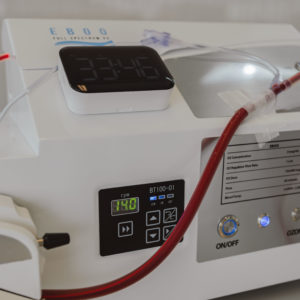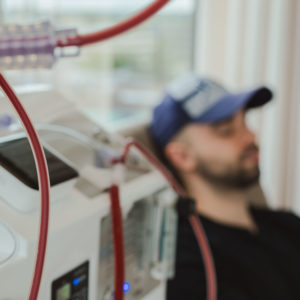8 min|Integrative
Mitochondria (Part 6): Change Your Lifestyle, Change Your Mitochondria
Wellness, HealthRecharge Your Cells: How Lifestyle Choices Affect Your Mitochondria
In Part 5, we learnt how our dietary choices could support the health of our mitochondria, the powerhouses of our cells. But there are many routes to healthy mitochondria, beyond what we choose to eat. Our habits can work with our mitochondria, promoting energy production, clearer thinking, better quality sleep, and healthy body composition. And many of these habits are easy to incorporate, no equipment required. Help your mitochondria, help you - and can feel what it’s like to become an energy efficient powerhouse.
Detox Your Life
Many toxins interfere with mitochondrial activity, including alcohol, pesticides, fluoride, and heavy metals.(1,2,3,4) Certain metals, such as lead, mercury, and cadmium appear to accumulate within the mitochondria.(5,6,7) Generally, mitochondrial DNA appears to be more susceptible to the effects of toxins than DNA within the cell’s nucleus.(8) Due to this, it is vital to limit our toxic exposure whenever possible, by:
- Choosing organic produce
- Using organic, toxin-free beauty products: https://www.ewg.org/skindeep/
- Filtering our water with a high-quality water filter, such as the Berkey https://berkeywaterfiltercanada.ca/
- Quitting smoking and avoiding secondhand smoke
- Limiting intake of large fish, such as tuna, marlin, shark, swordfish
- Limit intake of rice, as research has shown it to be contaminated with arsenic, regardless of source (9)
- Removing our shoes before entering the home, to avoid bringing in harmful pollutants
- Washing new clothes at least once before wearing to reduce exposure to contaminants typically used in clothing manufacturing (10)
Exercise
Exercise enhances mitochondrial biogenesis, aka the formation of new mitochondria.(11) High-intensity interval training (HIIT) decreases age-related mitochondrial decline.(12) Resistance training increases mitochondrial energy production.(13) In a study of elderly participants, light-medium cardio sessions (such as cycling or brisk walking) increased mitochondrial content of muscles.(14)
The more mitochondria we have, and the better they function, the more efficiently we process the food we eat, leading to better body composition and reduced risk of heart disease, insulin resistance, diabetes, and neurological disorders. Simply put? Get moving. Mix it up - incorporating brisk walking, strength training, and high-intensity interval training - to experience a wide variety of mitochondrial benefits. And, as always, consult with your doctor before starting a new exercise plan.
Say No to Drugs (if you can)
At times, medications are essential; there are certain situations in which we can feel grateful to have access to medications that can save our life. However, there are also times in which medications are freely prescribed, without exploring alternatives or fully discussing their risks and side effects. Many drugs negatively impact mitochondrial function, such as: certain antibiotics, such as tetracyclines (15); certain chemotherapy agents, such as doxorubicin (16); statins (17); salicylic acid, commonly sold as Aspirin (18); acetaminophen, commonly sold as Tylenol (19); certain anti-diabetic medications, such as Metformin (20); psychiatric medications such as SSRIs, valproic acid, and certain anti-psychotic medications (21). If you have been prescribed any of these medications (or any medication, for that matter), discuss their effects on your mitochondria with your doctor, determine if there is an alternative course of treatment, and if not, ask your doctor if there are steps you can take to mediate the detrimental effects.
Let There Be Light (if it’s the right kind)
Light can be thought of as an essential nutrient - it is vital to our body, particularly our mitochondria. But not all light is created equal - there is helpful light, and harmful light.
Sunlight is free and (mostly) accessible to all of us. It provides a full spectrum of natural light, the kind of light we evolved to interact with. Sunlight provides vitamin D, and produces vitamin D sulfate, a type of vitamin D that only the sun can create; taking a supplement cannot this kind. Stay out of the sun, or cover yourself in clothing or sunscreen constantly, and your body, and mitochondria, will not reap the benefits of the sun. Of course, there are some concerns regarding over-exposure to sunlight, and we definitely do not want to be out long enough to burn. However, at least 10-20 minutes of pure sunlight* on both bare skin and eyes (no sunscreen or sunglasses), preferably at sunrise, is beneficial to vitamin D levels, hormonal regulation, and mitochondrial function.(22,23,24) Additionally, you may benefit from vitamin D supplementation, depending on your accessibility to sunlight.
Sunlight also plays a key role in regulating our circadian rhythm - the 24-hour internal clock that dictates hormonal release and signaling. But there’s a type of light that hijacks this system, negatively impacting our hormonal release: blue light. Our circadian rhythm is largely controlled by melanopsin receptors in our eyes (25); unfortunately, these receptors are sensitive to blue light. In the presence of blue light, the melanopsin receptor triggers cortisol release, leading to alertness and delayed sleep.(26)
Alternatively, red light donates photons to your mitochondria.(27) Additionally, red light exposure has been shown to stimulate collagen synthesis (28), reduce pain and inflammation (29), and increase ATP production.(30)
Phew - so what does this all mean for you or I? Basically, we need to embrace a bit of sunlight and red light, and significantly decrease our blue light exposure, especially at night. First thing in the morning, get out in the sun for a short period of time. In the evening, as the sun sets, dim the lights, turn off all your blue-light emitting screens (this includes all technology with a screen), and keep your sleeping area very dark. If possible, up the ante and purchase blackout blinds, and switch your bedroom and bathroom lights to red light bulbs. Consider red-light therapy, such as infrared sauna or the Joovv (https://joovv.com). And if you must use technology at night, or you’re a shift-worker who has to be up during the night, consider using blue-blocking glasses, technology-adjusting software such as f.lux (https://justgetflux.com), or change the settings on your Apple products to limit blue light.
Supplement
Wow - can you believe we made it this far without mentioning supplements? Clearly, there is a lot that we can do for our mitochondria before we take a single pill. But if we are looking to provide a further boost to our mitochondria, supplements can be helpful, particularly if we are struggling from significant mitochondrial dysfunction. While there are many nutrients under consideration for enhancing mitochondrial function, there are a few that are already showing promises results:
- Alpha lipoid acid (ALA): shown to restore Complex IV activity, a key component of the electron transport chain (31)
- CoQ10, a key cofactor in the electron transport chain: led to improvements in symptoms of mitochondrial myopathies and neurodegenerative disorders in humans (32)
- Pyrroloquinoline quinone (PQQ): shown to stimulate mitochondrial biogenesis in mice (33), and reduce markers of inflammation in humans (34)
- Oxaloacetic acid (OAA): shown to promote mitochondrial biogenesis and reduce neuroinflammation in mice (35), reduced blood glucose levels in diabetic humans (36), and protect against damage to mitochondrial DNA in mice (37)
- Sulforaphane (sprout extract): activates Nfr2, leading to the promotion of ATP production (38)
Many of these ingredients are appearing in mitochondrial-focused supplements. Discuss with your doctor to determine if you might benefit from taking any of these individual nutrients, or a combination.
Three Cheers for 3-Os
Ozone, as in O3, is comprised of three oxygen atoms. This composition leads to its healing properties, allowing it to donate electrons into the Krebs cycle and stimulate ATP production. Ozone therapy has been shown to “induce positive and long-lasting cellular responses” (39), as well as beneficial alterations of mitochondrial respiratory chain enzymes.(40,41) When combined with CoQ10, ozone therapy was shown to protect against oxidative damage.(42)
Ozone therapy can be delivered through various methods, including rectal insufflation, vaginal insufflation, Prolozone, and major autohemotherapy (MAH), in which a volume of patient’s blood is removed (typically 50-250cc), mixed with ozone therapy, and reintroduced to the vein. Ozone therapy has been utilized safely in Germany since the 1950s; we are beginning to see its usage adopted in North America, and an increase in investigation into what we suspect are extensive medical indications. Currently, we are utilizing it at Integrative in cases of autoimmune diseases, chronic infections, cancer, significant injury, severe wounds, and mitochondrial dysfunction. If you are suffering from any of the conditions, or are looking to enhance your mitochondrial function, discuss with your doctor as to whether you are a candidate for ozone therapy.
Usually, when we are unwell, we think about what hurts - we rub our head if we have a headache, we go for a massage if our muscles ache, and maybe we even pop a supplement or medication if our stomach hurts. But its time we start thinking smaller, and considering how a tiny component of our cell - our mitochondria - can dictate the health of that cell, which can affect the health of our organs, and can create health - or hurt - throughout our body. Maybe if we start to help our mitochondria, we’ll find that they help us, leading not only to better health, but better aging, and a world where we don’t accept that certain symptoms are just ‘part of getting older’.
*Unless you are on a medication that increases photosensitivity
By making conscious lifestyle changes and adopting habits that support your cellular energy, you can ignite a powerful transformation within your body. Remember that your choices, from the foods you eat to the quality of your sleep, have a direct impact on your mitochondrial health. Take charge of your well-being by nurturing your mitochondria and experiencing the far-reaching benefits of a revitalized cellular system. Embrace the power of lifestyle changes to optimize your mitochondria, and watch as your body thrives in a state of vibrant energy and wellness.
REFERENCES
- https://www.sciencedirect.com/science/article/pii/S0016508502000379
- https://www.ncbi.nlm.nih.gov/pubmed/16263381
- https://www.ncbi.nlm.nih.gov/pmc/articles/PMC4071036/
- https://www.hindawi.com/journals/omcl/2016/5137042/
- https://www.ncbi.nlm.nih.gov/pmc/articles/PMC1008908/
- https://www.ncbi.nlm.nih.gov/pubmed/7516300
- https://www.ncbi.nlm.nih.gov/pubmed/15993495
- https://www.ncbi.nlm.nih.gov/pmc/articles/PMC3693132/
- https://www.consumerreports.org/cro/magazine/2015/01/how-much-arsenic-is-in-your-rice/index.htm
- https://consumerist.com/2015/05/18/how-important-is-it-to-wash-new-clothes-before-wearing-them/
- http://www.jbc.org/content/282/1/194.full
- https://www.cell.com/cell-metabolism/fulltext/S1550-4131(17)30099-2
- https://www.ncbi.nlm.nih.gov/pmc/articles/PMC4478283/
- https://www.ncbi.nlm.nih.gov/pmc/articles/PMC1540458/
- https://www.ncbi.nlm.nih.gov/pmc/articles/PMC4631686/
- https://www.ncbi.nlm.nih.gov/pubmed/7678246
- https://www.ncbi.nlm.nih.gov/pmc/articles/PMC5575577/
- https://www.ncbi.nlm.nih.gov/pmc/articles/PMC316328/
- http://www.jbc.org/content/283/20/13565.full
- https://www.ncbi.nlm.nih.gov/pmc/articles/PMC4147388/
- https://www.nature.com/articles/nrn3229-c1
- https://www.ncbi.nlm.nih.gov/pubmed/18180454/
- https://www.ncbi.nlm.nih.gov/pmc/articles/PMC2290997/
- https://www.ncbi.nlm.nih.gov/pubmed/24198392
- https://www.ncbi.nlm.nih.gov/pmc/articles/PMC5654534/
- https://www.ncbi.nlm.nih.gov/pmc/articles/PMC4898879/
- http://spie.org/newsroom/1669-low-level-laser-therapy-an-emerging-clinical-paradigm?SSO=1
- https://www.ncbi.nlm.nih.gov/pmc/articles/PMC3926176/
- https://www.ncbi.nlm.nih.gov/pmc/articles/PMC5523874/
- https://www.ncbi.nlm.nih.gov/pmc/articles/PMC5215870/
- https://www.ncbi.nlm.nih.gov/pmc/articles/PMC3268156/
- https://www.ncbi.nlm.nih.gov/pubmed/19932599/
- https://www.ncbi.nlm.nih.gov/pmc/articles/PMC2804159/
- https://www.ncbi.nlm.nih.gov/pubmed/24231099
- https://www.ncbi.nlm.nih.gov/pubmed/25027327
- https://www.ncbi.nlm.nih.gov/pubmed/4884771
- https://www.ncbi.nlm.nih.gov/pubmed/12749815
- https://www.sciencedirect.com/science/article/pii/S0891584915002129
- https://www.ncbi.nlm.nih.gov/pmc/articles/PMC4503975/
- https://www.ncbi.nlm.nih.gov/pubmed/17458689/
- https://www.ncbi.nlm.nih.gov/pubmed/24111149/
- https://link.springer.com/article/10.1007/s11845-011-0675-7
Related Articles

8 min|Dr. Alex Chan
EBOO for Chronic Inflammation: A Natural Approach for Systemic Relief
Regenerative Medicine, EBOO Therapy
8 min|Dr. Alex Chan
EBOO Therapy for Autoimmune Conditions: Exploring the Potential Benefits
Autoimmune Disease, Regenerative Medicine, EBOO Therapy


